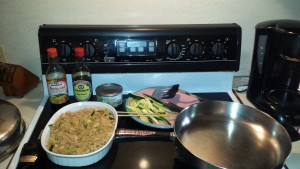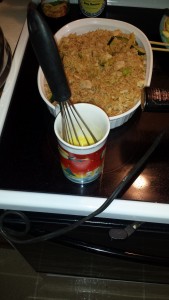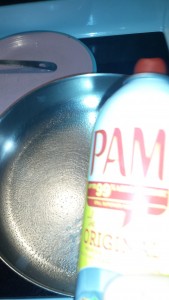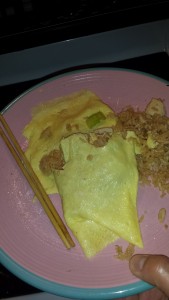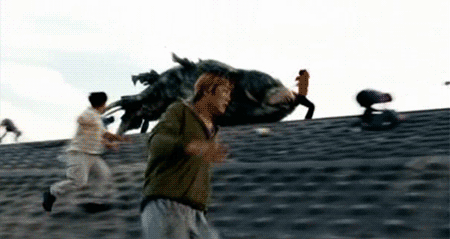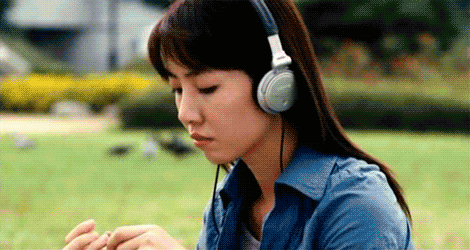So, keeping somewhat with the “Korea” theme that has been running through my last two blog posts (this one and this one), I will go ahead and make it a trilogy before moving on to something else. For today’s blog post, I will write about one of my all-time favorite foods, one I ate for the first time in Korea and have recently begun attempting to make at home, omurice. I will relate not only my personal recipe for omurice but also a brief history of the dish and an anecdote or two about the Korean restaurant where I first ate it. In keeping with the style and presentation of this blog, I will accomplish these things in the meandering, idiosyncratic fashion that the four or five people who actually read my blog have come to know and begrudgingly tolerate. For a more concise version of the history of this simple (and delicious, and nutritious) dish, refer to the Wikipedia article linked to above, and for undoubtedly better recipes, well, search the internet.
Anyone who has even glanced at the Wikipedia article now knows that omurice didn’t originate in Korea. It originated in Japan during the Meiji Restoration, a period spanning from 1868 to 1912 that restored imperial rule in Japan and contributed to its emergence as a modern nation at the beginning of the twentieth century.
By the way, the information I am giving about the history of Japan is taken directly from the Wikipedia pages I am providing links to. A week or two ago, after deciding to attempt to make my own omurice at home, I began to wonder if omurice had originated in Korea or Japan. I knew it was widely available in both countries, but I wasn’t sure where it appeared first. I consulted Wikipedia, and I found myself going down a rabbit hole of interesting articles, which I am now referencing and linking to here. So anyways, I will now continue:
There were many motivations behind the Meiji Restoration — and I invite the reader to investigate them if she or he wishes — but the one I feel is most relevant to the subject of this blog post is that Japan had begun to make contact with the western world, specifically the arrival of Commodore Matthew C. Perry in the 1850s. Perry went to Japan at the request of American President Millard Fillmore to force Japan into trading with the USA. According to Wikipedia, this expedition was authorized to use “gunboat diplomacy” if necessary, however, according at least to my very limited reading on the subject, the process was mostly peaceful.
At any rate, Japanese rulers recognized that Perry’s ships were superior to their own, and that in order to protect Japan from naval defeat (should the situation arise) and possible colonization, Japan had to modernize its navy as well as industry, which was a major motivation for the Meiji Restoration that officially began about a decade and a half after Perry came and forced open trade routes.
The Meiji Restoration was not limited to industrial and military advances, however. Japanese officials noted that not only were western ships bigger than Japanese ships, but westerners themselves were generally physically larger than Japanese people. It was believed at the time that this difference in size could be attributed to differences in diet. Westerners ate more meat (the consumption of red meat was banned in Japan, prior to the Meiji Restoration), and Japanese officials thought that shifting Japanese people to a more carnivorous diet might help them to catch up with the westerners in terms of size.
I have no idea if this actually worked. I encourage anyone who wants to research it further to do so and post their findings in the comments below. What I do know is that this plan was followed through with. Many western-influenced dishes began being made in Japan during the Meiji Restoration. These dishes were called “洋食” (pronounced “yōshoku”), which simply means “western food” or “western cuisine.”
As the reader may have intuited, omurice was originally considered to be yōshoku. It originated around the turn of the century in the Ginza district of Tokyo.
While it may or may not be clear whether eating western-inspired food ever made Japanese people physically larger, another aspect of the Meiji Restoration was most certainly successful: Japan’s navy and military made significant advances during the period, which made them (at least temporarily) militarily superior in their part of the world. This military superiority was possibly a motivating factor in Japan’s annexation of the Korean Peninsula in 1910 and their subsequent colonization of Korea, which lasted until Japan’s defeat at the end of World War II.
Many terrible things occurred during this colonization. The reader can use the provided link as a jumping off point for research if she or he wishes. The Japanese occupation of Korea was quite brutal, and resentments from this period still resonate among some Korean people.
For the purposes of this blog post, however, I will concentrate on a much more, well, “palatable” result of the occupation: the dishes that Japanese occupiers brought with them.
It should be obvious that omurice is one of these dishes. Gimbap is another.
The first time — or at least one of the first times — I ever ate omurice was at a gimbap restaurant near where I worked in Gimpo. This restaurant was part of a chain called “김밥나라” (“Gimbap Nara,” literally “Gimbap Country”), which was (I am guessing) the second-largest chain of gimbap restaurants behind “김밥천국” (“Gimbap Cheongook,” literally “Gimbap Heaven”). That was at least true in Gimpo when I lived there: there were more of the one restaurant than the other in my area.
Something else that was true regarding gimbap restaurants, at least when I lived in Korea: food quality varied quite a bit from restaurant to restaurant. All of the ones in Gimpo were pretty good, but some of them I went to in Seoul were, well, not as good. This was due to owners who used cheap ingredients, I imagine.
Anyways, the 김밥나라 I first ate omurice at (or I at least ate it there one of the first times, and then many times after) was also the first place I tried gimbap. I was brought there by a Canadian fellow who I was replacing at my school. This fellow seemed to be on friendly terms with the owner of the place (a Korean man, probably in his late 30s or early 40s at the time), and when I was first taken there, the Canadian fellow talked to him in Korean, and the owner smiled really big and pulled out a chair for him and nodded and bowed a little and everything, and anyways I enjoyed the gimbap and the friendly atmosphere and whatnot, so I resolved to eat there again after the Canadian fellow I was replacing went back to Canada or to wherever he was going.
Unfortunately, it took me a week or two to find the place again. I wandered around Gimpo looking for it, but I couldn’t find it. Most gimbap places look pretty much the same from the outside, you see, and long story short pretty much every one I passed by I went in, looking for the interior and the owner I would recognize.
Eventually I found it, and I went back. I didn’t know how to speak any Korean at the time, and maybe that’s why I never got the whole chair-pulling-out-welcome-to-my-restaurant-o-white-man-from-afar treatment the Canadian fellow got. Which didn’t honestly bother me much, honestly, but whatever.
I would go to this restaurant (and others similar to it) and try something random from the menu. Between doing this and staring blankly at screens on subway trains that showed the name of each station in both Hangeul and English, I was able to figure out how to phonetically read the Korean language. As an aside, it’s actually much easier to read than English is, no matter what you may think.
But I digress. While going to various gimbap places and ordering random dishes from the menu (pretty much all of which I came to love), I discovered two things: one, omurice is awesome, and two, the restaurant I went to with the Canadian fellow that one time charged about 500 won (roughly 50 cents) less for many menu items than other nearby restaurants did. Plus, in my opinion, the food tasted better, or at least better than the other gimbap place about a block away. So I started going there pretty regularly for lunch.
For one more quick digression, I think omurice cost either 2500 or 3000 won at this restaurant. Maybe 3500. And it came with two or three banchan, or side dishes (kimchi was always included, plus a couple others), which would be replenished free of charge if you ran out of them. Bearing in mind that 3000 won is roughly three dollars, it was possible for 200-something pound me to get really full at this place for five bucks.
So I started going there pretty regularly. And I never got the whole production the one Canadian guy got that one time, I just got the normal “오서오세요” (roughly “ohsohsayyo”; it means “welcome”) that everybody else got when they came in. Which was actually preferable to me: I didn’t want to be treated differently or anything because I wasn’t Korean.
One of the first things I learned to say in Korean was “감사합니다,” (pronounced, by syllable, “kam sa hab ni da” but usually sort of blended together in actual pronunciation to something like “kamsamnida”; it means “thank you”), and when my server would bring my food out, I would generally say my best approximation of “감사합니다” in response. It made sense for me to do so, from my point of view, because back here in the States, I would generally say “thank you” to the server. I was raised saying “please” and “thank you” and all that sort of stuff, and anyways I figured it’d be appropriate for me to continue that practice in Korea to the best of my ability.
Something I didn’t notice (at first) was that the Korean people who were in the restaurant when I was didn’t generally say “감사합니다” when the server brought their food to them. And one day, as I was sitting in the restaurant, at the seat next to the water cooler I preferred (many Korean foods are really spicy, do the math), as the owner of the place sat behind me and to my left, rolling gimbap, one of the servers brought him a cup of coffee.
When she handed it to him, he said “감사합니다!” in an animated fashion and bowed to her. She covered her mouth and giggled.
I hadn’t eaten one bite of kimchi yet, and I could feel my face turning red. Here I was, trying to bring my Southern version of “good manners” to Korea with me, in a show of fellowship and camaraderie and all that good stuff, and they were having a laugh over it!
So, when my food was brought out to me, what did I do? Did I sit silently, shamed at my well-intentioned but apparently hilarious series of faux pas? Nope. You know what I did?
When the server placed my food in front of me, I said “감사합니다” and ate it. And I came back a day or two later and did the same thing, and I came back many many times after that and did the same thing. The food was good, the food was cheap, and if they got a laugh out of me saying “thank you” then I am glad I brightened their day a little.
(Or whatever, I mainly kept coming back because their food was really good. And cheap.)
It may or may not be weird that I actually preferred being the butt of a harmless joke than being treated like I was a visiting dignitary or something. Nonetheless there you have it.
Anyways, on with the show:
As I mentioned in the opening paragraph, I have recently begun attempting to make omurice at home. Here is a picture of my most presentable omurice to date:
…which, as you can see, is sorta busted on one side. I haven’t figured out how to flip the thing without tearing it just yet.
But let me back up and tell you first how I prepared the fried rice that’s in it. And bear in mind that I am no chef, or even a short-order cook, and my recipe was taken off of the internet and modified to suit both the ingredients available to me and my ineptitude in the kitchen.
First, I cook some plain white rice in my rice cooker. I use Imperial Dragon Jasmine Rice. I don’t add anything to it at this point but the appropriate amount of water. I am not sure exactly how much uncooked rice this is, but my rice cooker came with a measuring cup, and I used two cupfuls. I think they are about a cup apiece, but I am not sure. What can I say, I meant to check before I came to the library today to write this, but I forgot to.
After the rice is done, I usually have a little of it, maybe a small bowl or so, then I let the rest cool. After the rice is cooled, I’ll put it in the fridge overnight. The recipe I found for “fried rice” a few years ago recommended doing this; however this last time I didn’t put the rice in the fridge and it worked just fine.
What I do first is put a little canola oil in a pan and stir-fry whichever vegetables I am using. I have used leeks, green onions, purple onions, white onions, usually whichever type of onion or onion-y vegetable I had on hand. I didn’t use them all at once, of course. Many Chinese restaurants (buffets, especially) will put peas and carrots into their fried rice…I don’t really care for peas and carrots in that situation, but do whatever suits you. I mean, if you want “authentic” fried rice, go to a restaurant or something.
The vegetables I used this time were, admittedly, a bit odd: I used about half of a zucchini, cut into strips, and three or four “celery hearts” from the middle of the stalk, ones that were a bit limp and on the verge of being thrown out. They happened to be in the fridge, and they weren’t brown or anything, so I chopped them up and stir-fried them with the zucchini, on medium heat with a little soy sauce.
After the zucchini started to get soft, I chopped them into smaller pieces with my spatula. And when I decided the veggies were cooked well enough, I added the cooked white rice, breaking up chunks of it with my fingers as I did so. I stirred it up and added more soy sauce, just enough to give the rice a brownish sort of color and a little flavor.
In my experience, it’s really easy to add too much soy sauce at this point, which will result in an inedible salty mess. I usually err on the side of caution here.
After that’s all been well-mixed and it’s mostly heated up, I push it all to one side of the pan. I drain a can of chicken breast and put it in the pan, smashing the chunks into smaller bits, and adding a tablespoon or so of teryaki sauce to it. I get the chicken (which is pre-cooked) warmed up before mixing it into the rice. The end result is what you see here, in the white container:
Note the zucchini on the plate behind it. There’s bits of celery there, also. I sliced up the whole zucchini and began stir frying it before realizing that the pan wasn’t big enough for the rice.
(I also cleaned that electric skillet out before I took this pic, ha ha.)
As a sidenote, I have also used pan-fried chicken breast, stir-fried shrimp, and I really wouldn’t recommend it but also those canned “tiny shrimp” when making fried rice at home. The canned chicken is just simpler, and after reading the Wikipedia article saying omurice is typically filled with chicken flavored rice, I decided to use that this time. I am strongly considering shrimp for my next batch.
Anyways, when I have made “fried rice” (I use quotation marks because I cook my fried rice at a lower temperature than is usually done in restaurants; I have tried higher temps but I usually make a huge mess trying to stir the rice fast enough to keep it from scorching) in the past, I usually cook a couple scrambled eggs beforehand and set them aside, then return them to the pan at the end and chop them up. I left out that step here, obviously, because I want to keep the egg on the outside.
So, after the fried rice is ready (or re-heated in the microwave, whatever the case may be), I scramble two eggs, the “whisk in a coffee cup” method seems to work well:
Then I set the pan or electric skillet to medium, let it get warm enough for a drop of water to sizzle when it hits it, then spray it down with Pam, apologies for the flash in the pic:
Then I pour the eggs into the pan, making sure the entire bottom of the pan is coated with egg. I let the eggs cook for thirty seconds or so, until I can see that the egg is starting to solidify, then I scoop probably about a cup or a cup and a half of fried rice onto one side of the egg, spreading it evenly.
Then, and here’s the hard part, I carefully fold the other side of the egg up and over the fried rice, just like a regular omelette. Since this is a pretty big electric skillet (I use a regular pan/skillet about the same size, also), the egg is pretty thin. So I have to use the spatula to lift it up, and my fingers to kinda pull it on over and put it in place. I let it cook for another 30 seconds or so, then very carefully flip the whole thing over and let it cook another 30 seconds or so.
I am confident there is a better way to do this. If anybody knows what that is, please tell me in the comments section.
I haven’t been able to completely seal off the rice inside the layer of egg, like it often was in various Korean restaurants I ate at. I have seen pics online of some omurice that looks like maybe the rice was put in the center and both sides were folded up over it, like a burrito. I tried that a couple times and bungled it all up.
It still tasted good, tho.
Anyways, thanks for reading.

